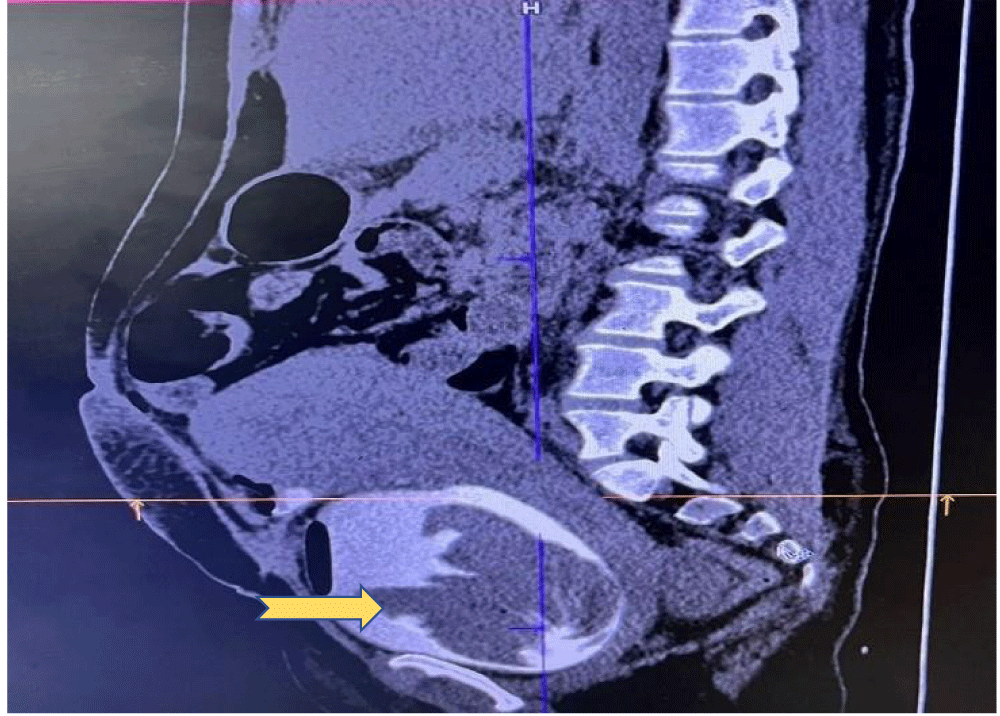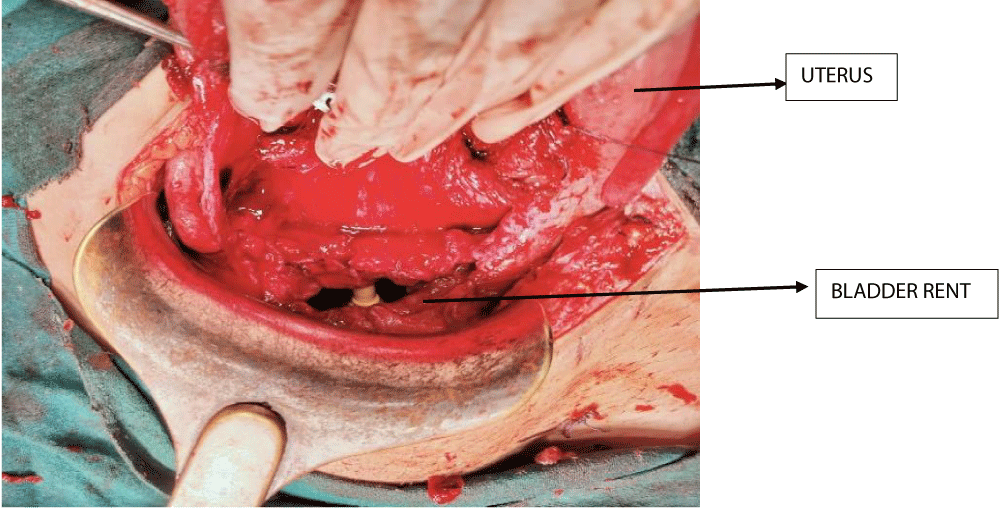Global Journal of Medical and Clinical Case Reports
Mysterious Intermittent Hematuria after Caesarean Delivery: Case Report and Comprehensive Review
Nasreen Noor*, Sahana SM, Shazia Parveen, Manzoor Ahmad, Abu Nadeem, Priyanka Sharma and Zakia Almas
Department of Obstetrics and Gynaecology, Jawaharlal Nehru Medical College, A.M.U., Aligarh 202002, U.P, India
Cite this as
Noor N, Sahana SM, Parveen S, Ahmad M, Nadeem A, Sharma P, et al. Mysterious Intermittent Hematuria after Caesarean Delivery: Case Report and Comprehensive Review. Glob J Medical Clin Case Rep. 2025:12(7):161-164. Available from: 10.17352/2455-5282.000219Copyright License
© 2025 Noor N, et al. This is an open-access article distributed under the terms of the Creative Commons Attribution License, which permits unrestricted use, distribution, and reproduction in any medium, provided the original author and source are credited.Background
Caesarean delivery is a cornerstone of obstetrics; its rate is likely to increase due to decreasing rates of vaginal birth after caesarean section (VBAC) and primary cesarean delivery on maternal request, which carries the inherent risk for intraoperative complications. Incidence of urinary bladder injury during primary caesarean section is about 0.2% and during repeat caesarean section is about 0.6% [1]. Risk factors for bladder injury during cesarean section include prolonged labor, scarred uterus (previous caesarean section, myomectomy, D&C), intraabdominal adhesions, emergency caesarean section, advanced labor, caesarean hysterectomy, etc. Most bladder injuries are recognized at the time of surgery, which is important, as quick recognition and repair are associated with a significant reduction in patient mortality. Here, we report a delayed recognition of iatrogenic bladder injury in a post-caesarean patient with intermittent hematuria. She ultimately underwent laparotomy followed by bladder repair.
Case presentation
A 33-year-old woman P3+1 L3 presented to us in emergency triage on post op day 2 with intermittent hematuria. She had previously had two cesarean sections, and two days earlier, while in labor during her current pregnancy, she had a third caesarean section performed at a private hospital. She had intermittent bouts of hematuria after the two-hour procedure. No history of fever, blood transfusions, or significant vaginal bleeding. In a private hospital. Following two hours of operation, she experienced sporadic episodes of hematuria. No history of severe bleeding per vaginum or blood transfusion or fever, or bleeding from any other site. There was no significant prior medical history of any kind. On examination, general condition was fair; cardiovascular and respiratory systems were unremarkable. She had tachycardia PR = 120 per min. BP = 100/62 mmHg, Temp 38 °C, respiratory rate 19 min.
Per-abdomen findings showed well well-contracted uterus ~ 20 weeks, dressing on the lower abdomen was not soaked. Vaginal examination revealed healthy lochia. Baseline investigations showed moderate anemia {Hb-8.6 gm/dL}, and urine microscopy showed 10-15 RBCs. LFT, RFT, and Coagulation profile were within normal range. Her CT Cystogram revealed hematoma of 300c.c. in right parametrium and dilatation of right pelvicalyceal system (Figure 1) (Table 1).
After consulting with a urologist, she was scheduled for an emergency laparotomy. Written informed consent was taken. Under general anesthesia, laparotomy was performed. There was around 3cm of rent on the bladder dome (Figure 2).
Sharp dissection was used to separate the anterior wall of the bladder from the anterior wall of the uterus. Around one liter of hematoma was found inside the bladder. After evacuation of blood clots, bladder rent repaired in continuous manner in 2 layers using Vicryl 2-0. Suprapubic cystostomy done. Uterine stitches opened up, cavity examined, and uterus closed in layers. A drain is put in situ, and the abdomen closed in layers. One unit of packed red blood cell transfused intraoperatively. Patient withstood the procedure well. Suprapubic and Foleys catheters were allowed to remain patent for 21 days.
After three weeks, the patient made a full recovery, following which both catheters were removed and the patient was discharged in satisfactory condition.
Discussion
Intermittent hematuria post-C-section arises from bladder injuries, vesicouterine fistulae, uterine/bladder rupture, infections, or PPH-related complications. The pathophysiology involves surgical trauma, inflammation, or fistulous communications, with intermittency driven by healing processes or episodic triggers. Clinical dilemmas stem from diagnostic uncertainty, the need for risk stratification, and balancing conservative versus invasive management. Recent literature underscores the role of prior caesarean sections in increasing adhesion-related complications, necessitating thorough evaluation with imaging and cystoscopy. The absence of symptoms (asymptomatic hematuria) complicates decision-making, as up to 57.6% of women have no identifiable cause after evaluation. Low-risk intermittent cases of intermittent haematuria are considered observation (serial urinalysis, non-invasive imaging). While intermediate/high-risk Underlying Causes Specific to Post-Cesarean State.
Ureteric injury with fistula formation: Iatrogenic injuries during lower segment C‑section may result in delayed uretero-uterine or uretero-vesical fistulas. Patients can present with cyclic hematuria [2].
Vesicouterine fistula (VUF) is an iatrogenic consequence of cesarean section in the vast majority of cases. The worldwide increase of cesarean delivery rates is likely to be accompanied by a rise in this complication, and surgery is the mainstay treatment [3]. In vesicouterine fistula (VUF), the bladder‑uterus connection may cause consistent or cyclic hematuria along with lack of vaginal bleeding (amenorrhea) and urinary symptoms. Ureteral obstruction or laceration: Iatrogenic ureteric injuries—either laceration, devascularization, or ligation—can lead to intermittent hematuria, flank pain, hydronephrosis, or reduced urine output; often diagnosed late in low‑resource settings.
The higher the number of previous caesarean sections higher the chance of bladder injury. Women with >3 prior caesarean sections are at 5 times risk of having bladder injury compared to those with 1 prior caesarean section. Similarly, Emergency caesarean sections are associated with increased bladder injury compared to elective caesarean section (31% vs. 11%). Caesarean section in laboring women also carries more risk of bladder injury compared to nonlaboring women (83% vs. 61%) [4].
Our patient presented here had a history of two prior cesarean sections and underwent LSCS during labor in current pregnancy, which predisposed her for iatrogenic bladder injury but was not recognised at the time of surgery. Although Cesarean deliveries are less prone to major maternal morbidities, they have nearly four times the increased incidence of bladder injury [5].
Interestingly, the rate of iatrogenic bladder injury in laparoscopic hysterectomy was found to be 21.1% in women who had at least three Cesarean deliveries compared to 1.2% in women without previous Cesarean delivery [6].
Risk factors for bladder injury [2]
Obstetricians should be aware of various conditions associated with increased risk for iatrogenic bladder injuries. They include, but are not limited to
- Prolonged labor with bladder distension
- Pregnancy with scarred uterus, e.g., myomectomy, metroplasty, repaired uterine perforation (septic abortion), etc.
- Suspected intra-abdominal adhesions, e.g., postoperative (nonuterine), pregnancy, chronic pelvic inflammatory disease, malignancy, irradiation, etc.
- Distorted local anatomy – cervical/lower segment fibroid, urogenital system anomaly, obstructed labor, etc.
- Advanced labor (Second stage LSCS), station ≥ +1 (due to well taken-up of cervix, uterine incision may fall over anterior vaginal wall, leading to difficult dissection of bladder from the field).
- Caesarean hysterectomy: Associated with ~ 1% - 4% of bladder injury, and this could be mainly attributed to poor visibility from haemorrhage from the gravid uterus and to placental invasion disorders, which may distort anatomical planes and invade the bladder [7].
Diagnosis of bladder injury
The presentation is either an immediate intraoperative event or delayed bladder rupture and urinary ascites.
Intraoperatively, bladder injury is recognised when there is visible bladder mucosa, visualisation of Foleys bulb, or urine dribbles out in the operative field, or if there is frank haematuria in Foleys tubing. Haematuria might occur in 95% cases.
Post-operatively, missed bladder injury can present as hematuria, oliguria, lower abdominal pain, ileus, ascites, urinary peritonitis, sepsis, and elevated blood urea nitrogen and creatinine levels.
Our patient presented with hematuria, but the peculiarity here is its nature, which was intermittent. Possible hypothesis for this symptom is that there was clear urine drainage when a large blood clot sealed the bladder rent, and during its dislodgement, there was blood-stained urine drainage leading to intermittent hematuria.
If there is a suspicion about bladder injury, it can be confirmed by retrograde instillation of dye (methylene blue/ trypan blue, etc.) or sterile milk through transurethral catheter into the urinary bladder and observing the coloured leak [4].
If there is doubt of bladder trigone injury, cystoscopy, ureteric catheterization can be done. IV indigo carmine 10 - 15 minutes before cystoscopy reveals efflux of dye-stained urine from the ureters. In the absence of a cystoscope, a hysteroscope can be used [8].
Bladder injuries can be extraperitoneal or intraperitoneal. Mechanism of injury includes blunt, penetrating, or iatrogenic trauma. Most of the time during caesarean section, intraperitoneal bladder injury occurs, and usually it occurs at the dome of the bladder. Iatrogenic bladder injury can be classified as follows [9].
Grade 1: contusion, intramural hematoma, or partial thickness laceration
Grade 2: extraperitoneal bladder wall laceration 2 cm or intraperitoneal 2 cm
Grade 3: extraperitoneal >2 cm or intraperitoneal < 2 cm laceration
Grade 4: intraperitoneal bladder wall laceration >2 cm
Grade 5: intra- or extraperitoneal bladder wall laceration involving the trigone or bladder neck. The involvement of the posterior area of the bladder may raise the suspicion of trigonal and ureteral involvement. Grade 5 injury warrants calling the urologist or urogynecologist.
Management
Most bladder injuries are discovered intraoperatively, and with immediate repair, have a favorable outcome post-operatively. Delayed recognition of bladder injury can result in increased morbidity along with consequences such as vesicovaginal, vesicouterine, or uterovaginal fistulae.
The standard management of intraperitoneal iatrogenic bladder injury is surgical repair. Usually sutured in two layers using absorbable suture material (Polyglycolic acid no. 3-0). Any combination of repair—simple continuous suturing, interrupted suturing; excluding the bladder mucosa, through-&-through bladder mucosa heals adequately if it is performed meticulously. After the repair, retrograde instillation of at least 300 mL of saline with or without dye into the bladder can be done to check for leaks, and if noted, then an additional layer of imbricating sutures is applied to achieve water-tight closure.
Prolonged urine drainage by suprapubic cystotomy (SPC) catheter and transurethral Foley catheter is indicated for large injuries. While a transurethral Foley catheter alone would be sufficient for smaller rents. Preferred size of the catheter for suprapubic cystotomy catheter (28–24) Fr and Foley catheter (16–18) Fr. [4].
In certain cases, conservative management can be done using an indwelling transurethral Foley catheter alone, a percutaneous peritoneal drain alone, or combined Foley catheter and percutaneous peritoneal drain for complete urinary drainage. These methods avoid surgical and anaesthetic complications and should be considered in patients with iatrogenic intraperitoneal bladder injury without any signs of sepsis, deterioration, or peritonitis [10].
Prevention of urologic injuries: [7]
Different strategies to reduce the risk of bladder or ureteric injury during caesarean section or hysterectomy are
- Improved anatomical knowledge
- Strong uterine traction
- Careful dissection technique
- Prophylactic identification of ureters
- Bladder distension with fluid to clarify planes
- Avoiding diathermy near bladder/ureters
- Sharp dissection (as opposed to blunt traction) of the bladder away from the uterus
- Urethral catheterisation at the start of the case (Foleys catheter)
- Prophylactic ureteric catheters/stents
- Shielding the bladder with retractors
Baron J, et al. in 2018 described a novel Sliding sign technique in ultrasonography for diagnosing intra-abdominal adhesions. In the absence of adhesion, during deep breathing, the uterus will slide below the parietal fascia of the abdomen, whereas in case of severe adhesion, this sliding is absent [11].
Urological injury has a grave fear for surgeons; one should be reassured that bladder injuries detected and repaired intraoperatively are not associated with either short- or long-term complications. Identifying the source and cause of hematuria in the postpartum period can be challenging, requiring careful evaluation and potentially invasive procedures [12].
Conclusion
A prior cesarean delivery because of adhesion is the biggest risk factor for bladder damage during a cesarean operation. Most mild injuries to the bladder heal without any problems, and prompt, careful repair has great functional results. It’s unrecognized or delayed detection, however, may lead to higher rates of morbidity and mortality.
Identifying risk factors for bladder injury during caesarean deliveries, along with proper post-operative management and frequent follow up leads to a favourable outcome. Lastly, healthcare professionals need to be aware of and prepare for potential risks when operating on patients who have had multiple caesarean sections in the past.
- Eisenkop SM, Richman R, Platt LD, Paul RH. Urinary tract injury during cesarean section. Obstet Gynecol. 1982;60:591-6. Available from: https://pubmed.ncbi.nlm.nih.gov/7145252/
- Harzif AK, Maidarti M, Ginanjar I, Shadrina A, Meutia AP. Vesicouterine fistula presenting with cyclical haematuria mimicking bladder endometriosis: A case report. Int J Surg Case Rep. 2021;80:105709. Available from: https://doi.org/10.1016/j.ijscr.2021.105709
- Bulfoni A, Bonavina G, Acerboni S, Schirripa I, Casale P, Busnelli A. Vesicouterine Fistula After Cesarean Delivery at Full Cervical Dilation. Urogynecology (Phila). 2023;29(12):974-9. Available from: https://doi.org/10.1097/spv.0000000000001398
- Manidip P, Soma B. Cesarean bladder injury – obstetrician's nightmare. J Family Med Prim Care. 2020;9:4526-9. Available from: https://doi.org/10.4103/jfmpc.jfmpc_586_20
- Phipps MG, Watabe B, Clemons JL, Weitzen S, Myers DL. Risk factors for bladder injury during cesarean delivery. Obstet Gynecol. 2015;105:156–60. Available from: https://doi.org/10.1097/01.aog.0000149150.93552.78
- Wang L, Merkur H, Hardas G, Soo S, Lujic S. Laparoscopic hysterectomy in the presence of previous cesarean section: a review of one hundred forty-one cases in the Sydney West Advanced Pelvic Surgery Unit. J Minim Invasive Gynecol. 2020;17:186–91. Available from: https://doi.org/10.1016/j.jmig.2009.11.007
- Wei G, Harley F, O’Callaghan M, et al. Systematic review of urological injury during caesarean section and hysterectomy. Int Urogynecol J. 2023;34:371-89. Available from: https://doi.org/10.1007/s00192-022-05339-7
- Baskett TF, Calder AA, Arulkumaran S. Obstetrics hysterectomy. In: Munro Kerr’s Operative Obstetrics. 11th ed. Edinburgh: Saunders Elsevier. 2007;309-14. Available from: https://www.scirp.org/reference/referencespapers?referenceid=2451966
- Vaidya B, Chaudhari M, Parmar D, Chaudhari V, Daginawala T, Shah R. Bladder injuries during obstetrical and gynecological surgeries. Int Surg J. 2017;4:2177-80. Available from: http://dx.doi.org/10.18203/2349-2902.isj20172578
- Aghaways I, Bapir R, Hawrami TA, Thahir NM, Al Kadum Hassan MA, et al. Conservative management of delayed presentation of intraperitoneal bladder rupture following caesarean delivery: A case report. Int J Surg Case Rep. 2019;59:31–4. Available from: https://doi.org/10.1016/j.ijscr.2019.04.050
- Baron J, Tirosh D, Mastrolia SA, Ben-Haroush Y, Schwartz S, Kerner Y, et al. Sliding sign in third-trimester sonographic evaluation of intra-abdominal adhesions in women undergoing repeat Cesarean section: A novel technique. Ultrasound Obstet Gynecol. 2018;52:662-5. Available from: https://doi.org/10.1002/uog.19057
- Smith J, Brown K. Peripartum hematuria post-cesarean section: A case series. J Matern Fetal Neonatal Med. 2024;37(1):45–9.






